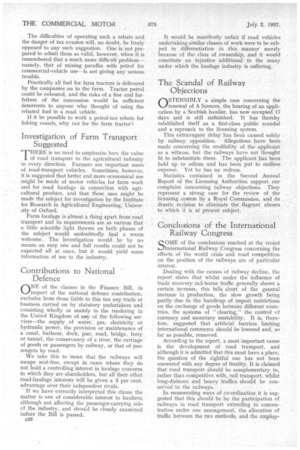Conclusions of the International Railway Congress
Page 64

Page 65

If you've noticed an error in this article please click here to report it so we can fix it.
SOME of the conclusions reached at the recent International Railway Congress concerning the effects of the world crisis and road competition on the position of the railways are of particular interest.
Dealing with the causes of railway decline, the report states that whilst under the influence of trade recovery rail-borne traffic generally shows a certain increase, this falls short of the general increase in production, the slow growth being partly due to the handicap of import restrictions on the exchange of goods between different countries, the systems of "clearing," the control of currency and monetary unstability. lit is, therefore, suggested that artificial barriers limiting international commerce should be lowered and, so far as possible, removed.
According to the report, a most important cause is the development of road transport, and although it is admitted that this must have a place, the question of the rightful one has not been answered with any degree of finality. It is claimed that road transport should be complementary to, rather than competitive with, rail transport, whilst long-distance and heavy traffics should be conserved to the railways.
In enumerating ways of co-ordination it is suggested that this should be by the participation of railways in road transport extending to concentration under one management, the allocation of traffic between the two methods, and the employ ment of conibined roadLraiI services such as containers, and the carriage by rail of loaded lorries or trailer's.
A particularly suggestive comment is that it is necessary that appropriate measures be taken to regulate the private transport of goods by road, especially over long distances, whilst it is desirable that the methods of public transport should adopt public tariffs based, so far as possible, on the same principles. This would avoid the unnecessary reduction of existing rates by both • 'parties. So far, the reduction of rates in specific cases, sometimes granted on the condition that firms hand over the whole of their transport to the railways, has given better results than general reductions.
Efficacious means for meeting competition are the increasing of the speed and frequency of trains and of their comfort, and on the goods side, regularity in delivery, acceleration and extension of door-to-door facilities.
What amounts to a confession of the disadvantages of monopoly is the advice that railways must continue to follow commercial measures proved sound in other spheres of business, especially since they no longer enjoy a virtual monopoly of transport. If all these points were brbtight into force, it Niyould appear that a practical railway, monopoly would again be instituted, and traders wrinld 'once more be cornered. In our opinion, the conclusions reached actually constitute an excellent case for road transport, and particularly that large section operated by private enterprise.




















































































































































